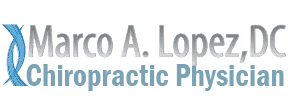Decompression refers to procedures intended to relieve pressure and nerve related pain presumably caused by a herniated disc that increases pressure on nearby nerve roots in the spinal canal. Decompression may be surgical or non-surgical. This article will address non-surgical spinal decompression performed by Doctors of Chiropractic.
Spinal Decompression alleviates pressure within the disc by creating space around the compressed nerve root. Decompression also allows nutrients to flow in/out of the disc space which normally occurs more slowly. The disc receives blood supply through the outer portion of the disc and through the outer surfaces of the vertebra on which the disc rests. Since blood supply is often limited healing occurs more slowly.
In the non-surgical setting, decompression is achieved by axial traction. Axial traction can be explained as a stretch caused forces pulling in opposite directions. Several methods exist to accomplish this end.
Static traction stretches the patient to tolerance and holds that position for a several minutes. Dynamic traction, also called intermittent traction, is similar to the above but cycles between periods of increased stretch and release over a period of several minutes which creates a cycled pressure change within the disc. Many of the spinal decompressions machines utilized by Chiropractors employ dynamic or intermittent traction. Insurance usually does not cover this procedure so patients typically pay for services out of pocket.
Flexion-Distraction or distraction manipulation is another type of spinal decompression usually performed manually by the treating doctor. Flexion Distraction would fall under the category of dynamic traction. However, it is more variable as the stretch and timing of treatment can be quickly adjusted by the treating doctor so the patient achieves the most benefit and least amount of discomfort. Moreover, this treatment option is performed within a shorter period of time compared to intermittent traction. The patient is slightly flexed or angled after being stretched which creates further space in the posterior structures of the spine and the intervertebral foramen (where nerves exit the spine.)
Flexion-Distraction offers more interaction between the doctor and patient. It is just as effective as mechanical decompression which makes it a good first option. Moreover, flexion-distraction will usually be covered as manipulation or manual therapy depending on your insurance plan. Every patient is unique and so results may vary. If this treatment does not work for you can always try the other static or dynamic traction machines.
As a whole, spinal decompression is helpful when patients are properly selected. Spinal care should always be diagnosis-based and tissue specific to achieve the best results. The doctor should identify the herniated disc as the source of your pain. Remember, not all herniations cause pain. However, when your pain radiates into the arm or leg a herniation is more likely. The doctor may perform orthopedic tests that stretch the nerve (neural tension tests) in various positions to determine the extent of the lesion. When other methods of conservative care fail to provide results intermittent decompression machines may provide relief.
In the event a person experiences intractable pain after exhausting conservative approaches, invasive procedures such epidural steroid injections or nerve blocks and surgical decompression provide other options. In this case, a pain specialist provides strategies for managing pain. This avenue is a viable option for those patients that refuse surgery and do not mind periodic injections to quell and control pain. Surgery has several concerns associated with it but has proven effective in those cases where conservative treatment fails to provide relief. An orthopedic surgeon or neurosurgeon would be best suited to discuss this option.
As a final note, diet heavily influences the perception of pain. The American diet tends to be highly inflammatory and will increase the pain response in most people by inducing pro-inflammatory chemicals in the body (prostaglandin, thromboxane, prostacyclin, leukotriene, tumor necrosis factor, interleukin, vascular endothelial growth factor, nerve growth factor, and several more). Unfortunately, diet is one of the most difficult habits to change and advice often falls on deaf ears. Those people brave enough to honestly question and change lifestyle can find several informational websites and books to help them along.
References:
Gay R, et al. Stress in Lumbar Intervertebral Discs during Distraction: A Cadaveric Study. Spine J. 2008 ; 8(6): 982–990.
Kruse R, et al. Chiropractic treatment of a pregnant patient with lumbar Radiculopathy. Journal of Chiropractic Medicine (2007) 6, 153–158
Gudavalli MR, Cambron JA, McGregor M, et al. A randomized clinical trial and subgroup analysis to compare flexion-distraction with active exercises for chronic low back pain. Eur Spine J 2006;15(7):1070-82
Bergmann TF, Jongeward BV. Manipulative therapy in lower back pain with leg pain and neurological deficit. J Manipulative Physiol Ther 1998;21(4):288-94.
Seaman DR. Clinical nutrition for pain, inflammation and tissue healing. Hendersonville (NC): NutrAnalysis, Inc.; 1998
